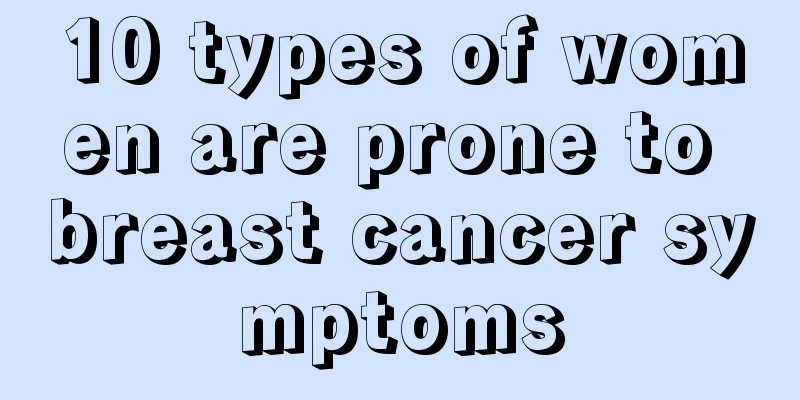10 types of women are prone to breast cancer symptoms

|
Due to the high pressure of work and life, psychological tension, irregular diet, poor sleep and other bad living habits, breast cancer has become a common disease among women. In fact, there are signs of breast cancer. There are 10 types of women who are more likely to have breast cancer symptoms and belong to the high-risk group for breast cancer. Early symptoms of breast cancer Have a family history of breast cancer British scientists recently conducted a study showing that one-third of breast cancer patients are caused by genetic inheritance. Scientists from Cambridge University recently published a report at the annual meeting of the British Institute of Cancer Research, saying that they found that if the BRCA1 and BRCA2 genes in the human body mutate, the chance of developing breast cancer will increase to 70% to 80%. However, they found that cases of mutations in these two genes only account for 5% of all breast cancer patients, and other women who develop breast cancer due to heredity are sick because of more complex gene combinations. Menarche before age 13 or late menopause Early menarche (menstruation before the age of 12), late menopause (menopause after the age of 50), and long menstrual period (more than 35 years) are all recognized risk factors for the disease. Statistics show that the risk of breast cancer doubles for every 4-5 years of menarche age. Those with menarche age of 13-15 years or older have a 20% lower chance of developing breast cancer than those under 12 years old. The incidence of breast cancer is lower for those under 55 years old during menopause. The risk of breast cancer is about doubled for those who reach menopause age of over 55 years old compared to those who reach menopause age of under 45 years old. Breast hyperplasia has not healed for many years Breast hyperplasia has four strange characteristics: first, a lump with unclear edges appears in the breast; second, premenstrual breast pain, which may even radiate to the shoulders or back, and is sometimes very uncomfortable; third, there is a possibility of cancer, especially in the cystic hyperplasia type, which is said to have a cancer rate of 0.35%; fourth, the treatment time is long, and the hyperplastic tissue is not sensitive to drugs, or in other words, there is still a lack of specific drugs for treatment. Therefore, breast hyperplasia still makes many doctors feel difficult and many women feel confused even in today's modern scientific development. Obesity or excessive fat intake Swedish and American scientists recently jointly published a study showing that young women with anorexia have a lower risk of breast cancer. This suggests that a woman's early calorie intake may have a greater impact on the formation and development of breast cancer. The researchers also warned that anorexia is a serious mental illness that can lead to some life-threatening complications. Therefore, women should not mistakenly interpret this research result as: starving can prevent breast cancer. Their research results only explain the possible formation mechanism of breast cancer. The researchers investigated the breast cancer situation of 7,303 Swedish women who were hospitalized for anorexia between 1965 and 1998. The women surveyed were all under 40 years old, and most of them had anorexia before the age of 20. Late marriage and late childbearing Data show that the risk of women who have never given birth is 30% higher than that of women who have given birth; the risk of women who have not breastfed is more than 1.5 times higher than that of breastfeeding women! Breast cancer is a type of malignant tumor with a relatively high incidence rate. Globally, its incidence rate is the highest. The incidence rate in China is relatively low, but it is increasing at a rate of 2%-5% each year. It is estimated that there are about 100,000 breast cancer patients in China every year, and the number of deaths is 40,000-50,000, so the mortality rate is relatively high. The characteristics of breast cancer in China are that it rises relatively quickly and the age tends to be earlier. It is understood that the peak incidence of breast cancer in Chinese people is 10-15 years earlier than that in Europe and the United States. The peak incidence in Europe and the United States is generally 56 years old, while in China it is 45-49 years old. The main reason is the problem of race. However, the younger age of breast cancer is also related to the improvement of our living standards. Studies have shown that a high-fat, low-fiber diet can increase the incidence of breast cancer by more than 4 times; a young woman who drinks 3-6 times a week, calculated as 250 ml of beer or 185 ml of strong liquor each time, will increase her risk of breast cancer in the future by 30%-60%. Not breastfeeding or breastfeeding for too long Discovery: Breast "dimples" beware of breast cancer: If dimples grow on your face, they may make you more charming and attractive, but if "dimples" suddenly grow on your breasts, it may be breast cancer. Most breast cancers do not cause obvious pain. In the early stages of the disease, about 5% of people may have bloody discharge from the nipples. When the tumor invades the skin, there are often depressions of varying degrees, which are called "dimple signs." "Dimple signs" prefer seven types of women: one is people with a family history of cancer, especially mothers or sisters who have had breast cancer; two is people with early menarche (under 12 years old) and late menopause (over 55 years old); three is people with certain benign breast diseases; four is people who often receive chest radiography or chest radiographs; five is people who have never breastfed, never given birth or gave birth too late or have had many miscarriages; six is women with high breast density and firm texture; seven is women who are particularly obese above the waist and have waist and hip circumferences similar. Breast lumps are the most important and basic symptom of breast cancer. They are usually located on the upper outer part of the breast and are usually about 2 cm in size and are irregular spherical masses. In addition, changes in the contour and curvature of the breast and the shape of the nipple, such as asymmetric breasts and inverted nipples, are also manifestations of breast cancer. Commonly used hormone drugs or cosmetics Some drugs, such as antihypertensive drugs reserpine, phenothiazole, and steroid drugs, have the effect of increasing the incidence of breast cancer. Some health products, skin care products, and cosmetics contain carcinogenic ingredients. Evidence-based medicine shows that hormone replacement therapy for women during menopause increases the risk of breast cancer, so women should not supplement estrogen and progesterone casually. Phthalates are a class of chemicals that can soften. They are widely used in toys, food packaging materials, medical blood bags and hoses, vinyl floors and wallpapers, detergents, lubricants, personal care products, such as nail polish, hair spray, soap and shampoo, and hundreds of other products. Among cosmetics, nail polish has the highest phthalate content, and many cosmetic fragrance ingredients also contain this substance. Professor Cheng Changmei, a professor at the Department of Chemistry at Tsinghua University, said that this substance in cosmetics can enter the body through the female respiratory system and skin. If used excessively, it will increase the risk of breast cancer in women and also harm the reproductive system of male babies they give birth to in the future. Repeated abortions Repeated abortions can greatly increase the likelihood of women developing breast cancer. A study showed that spontaneous abortion does not increase the risk of breast cancer; however, women who had abortions before the age of 18 have a 110% higher risk of breast cancer than those who have not had abortions. This is because after each abortion, the pregnancy is suddenly interrupted, the hormone level in the body drops suddenly, and the newly developed mammary glands suddenly stop growing, causing the alveoli to become smaller or even disappear, and the mammary glands to recover. However, this recovery is usually incomplete, which can easily cause breast lumps and pain, and can induce breast diseases. Repeated breast lesions can become the cause of breast cancer. Depression, often angry, bad mood Depression may be related to the current high-intensity life pressure. Many women have developed bad habits such as unreasonable diet structure, bad living habits, and excessive life pressure. Bad living habits bring depression. In the long run, it leads to acidification of the body, decline of human body function, poor blood circulation, endocrine hormone imbalance, menstrual disorders, etc., which can cause breast diseases, namely breast hyperplasia. If it is not treated, it may induce breast cancer. Repeated long-term exposure to various radiation (multiple radiation, computers, mobile phones, etc.) electromagnetic radiation. The breast is a tissue that is more sensitive to the carcinogenic activity of electromagnetic radiation. When you are young, it is the stage of breast mitosis activity and is most sensitive to the carcinogenic effect of electromagnetic radiation. |
<<: What kind of disease is endometrial cancer
>>: What harm does gastric cancer bring
Recommend
The symptoms of endometrial cancer are mainly manifested as
The symptoms of endometrial cancer mainly include...
How much sleep is normal for a nine-month-old baby?
A nine-month-old baby sleeps for a long time ever...
Reasons for sore and weak legs
Legs are an important part of the human body. We ...
The dangers of wearing contact lenses
Everyone knows about contact lenses, which are co...
Should we tell patients the truth about cancer?
In the outpatient or inpatient department of the ...
What to do if liver hardness value is high
The liver is actually a detoxification organ in o...
What are the effects and contraindications of Guilinggao
Guilinggao can play a very good role in reducing ...
How to clean suede seats
Nowadays, people are more concerned about dressin...
Anti-inflammatory drugs for inner ear vertigo
Sometimes some patients may feel that they always...
A solution to nails growing into the flesh
If the nails grow into the flesh, they need to be...
What kind of health tea should I drink during my period
What kind of health tea is good to drink during m...
How big is a breast cancer lump
The size of breast cancer lumps is an important i...
What are the symptoms of advanced liver cancer? Five symptoms of advanced liver cancer
For patients with advanced liver cancer, their li...
Why is my hair so oily
If a person's hair is too greasy, it will giv...
How to treat liver metastasis of lung cancer? Treatment of liver metastasis of lung cancer
The incidence of lung cancer in my country is ver...









